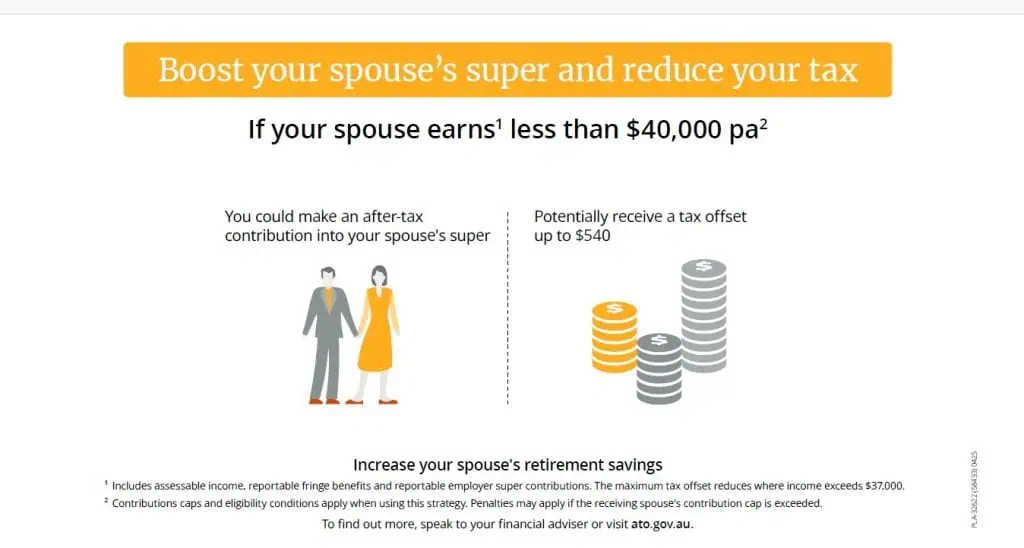Super strategies – Splitting your super contributions to your spouse
Splitting super contributions to your spouse’s super account may help to boost their retirement savings
and provide a range of other benefits.

How does the strategy work?
You may be able to split (transfer) eligible concessional contributions (CCs) that you’ve made or received to your spouse’s super account.
Eligible CCs include employer super contributions and personal super contributions for which you have claimed a tax deduction.
Contribution splitting can be a great way to increase your spouse’s super savings particularly where they, for example:
- are not working
- have had time out of the workforce, or
- have a lower super balance.
What’s the benefit?
In addition to boosting your spouse’s retirement savings, there may be other benefits depending on your specific circumstances.
Help to cover insurance premiums
Contribution splitting can help to pay your spouse’s insurance premiums for policies held inside super. This may be beneficial during times where your spouse has reduced their working hours or is out of the workforce and their contributions have reduced.
Maximise tax-free retirement savings
A limit applies to how much super can be transferred into ‘retirement phase’ income streams, where investment earnings are taxed at 0%. Contribution splitting may help you take better advantage of these limits as a couple and maximise the total amount you can hold tax-effectively when you retire.
Maximise Age Pension
If you have a younger spouse who is under age 67, contribution splitting may help to improve your Centrelink entitlements. Superannuation held in the ‘accumulation phase’ is not assessed for social security purposes until the account holder reaches their Age Pension age. Splitting super to your younger spouse may therefore reduce the assets assessed when your entitlement is calculated, potentially increasing your Age Pension entitlement.
What contributions can be split?
Only eligible CCs can be split to your spouse, such as superannuation guarantee (SG), salary sacrifice and personal deductible contributions. Non-concessional or ‘after-tax’ contributions cannot be split.
Generally, the maximum amount that can be split is the lesser of:
- 85% of your CCs for the year (after taking into account 15% contributions tax), or
- your CC cap for the financial year.
The CC cap is $30,000 in FY 2024/25 or may be higher if you didn’t contribute your full CC cap in any of the previous five financial years and are eligible to make ‘catch-up’ contributions.
You can generally only split CCs made in the previous financial year. Also, you need to request to split your CCs in writing to the trustee of your super fund within 12 months after the end of the financial year the CCs were made to your super fund (unless you’re going to roll over your balance or close your account).
CASE STUDY
Lucy would like to split some of her eligible CCs made during 2023/24 to her husband Luke’s (age 40) super fund.
In FY 2023/24, her employer contributed $20,000 to her super fund and her CC cap was $27,500. The maximum amount that Lucy can split to Luke is the lesser of:
- $17,000 (85% of the $20,000 contributed by her employer), and
- $27,500 (her CC cap in 2023/24). Lucy elects to split $15,000 of her CCs to Luke’s super fund and submits the contribution splitting application form to her fund in 2024/25.
Her super fund transfers $15,000 to Luke’s super fund. This won’t reduce Lucy’s CCs for the financial year and the transfer won’t be assessed as a contribution against Luke’s contribution caps.
Note: If Lucy was eligible to make larger CCs in 2023/24 using the ‘catch-up’ contribution rule, her CC cap may be greater than $27,500. This may increase the maximum amount of contributions she could potentially split to Luke if she made larger CCs in that financial year.
Is your spouse eligible?
To be eligible to split your super to your spouse, they must be either:
- under 60, or
- between 60 and under 65 and declare they are not currently retired for superannuation purposes.
Once your spouse reaches age 65, they are no longer eligible to receive a contribution split from your super.
Key considerations
- Contribution splitting may be used by married couples, de facto partners and same sex couples.
- Contributions split to your spouse:
- will form part of the taxable component of your spouse’s super account
- don’t count towards their CC cap, as they have already counted towards your CC cap in the year the contributions were made to your account.
- The split amount is fully preserved in the receiving spouse’s account and they can’t access their super until they meet certain conditions.
- Where a personal deductible contribution forms part or all of the amount to be split, a Notice of Intent to claim a tax deduction must be lodged and acknowledged by the super fund prior to the contribution split being processed.
- If you’re intending to rollover or withdraw your entire benefit and you wish to split CCs made in the same financial year or from the previous financial year, the split must be completed prior to the rollover or withdrawal request being processed.
- It’s not compulsory for a super fund to offer contribution splitting. You will need to check with your fund to see if they allow it.